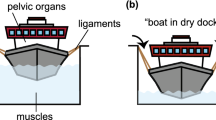Abstract
Introduction and hypothesis
Uniaxial tensile testing is commonly used to calculate values of mechanical properties of urogynecological prostheses used in stress urinary incontinence and pelvic organ prolapse surgery in women. Clinical behavior of these products has been linked to their mechanical properties, hence influencing the clinician’s preference for one brand or another. The objective of this study is to assess the effect of displacement rate used in uniaxial tensile testing on peak load, extension at peak load, and initial stiffness of Prolene® mesh, used as a proxy for urogynecological prostheses.
Methods
Strips of Prolene® mesh measuring 10 × 30 mm were submitted to uniaxial tensile testing at the following rates: 1, 10, 50, 100, and 500 mm/min. Peak load, elongation at peak load, and initial stiffness were computed from load vs displacement curves at all displacement rates. The effect of displacement rate on these parameters was estimated by fitting linear trend lines through the data.
Results
The displacement rate at which uniaxial tensile testing is performed has significant effects on the values of extension at peak load and initial stiffness, but not on the peak load.
Conclusions
When urogynecological prostheses are submitted to uniaxial tensile testing, studies at more than one displacement rate should be performed. More importantly, these displacement rates should be within the range of applicability.




Similar content being viewed by others
References
Fong ED, Nitti VW (2010) Review article: mid-urethral synthetic slings for female stress urinary incontinence. BJU Int 106:596–608
Amid PK (1997) Classification of biomaterials and their related complications in abdominal wall hernia surgery. Hernia 1:15–21
Thüroff JW, Abrams P, Andersson KE et al (2011) EAU guidelines on urinary incontinence. Eur Urol 59:387–400
Olsen AL, Smith VJ, Bergstrom JO et al (1997) Epidemiology of surgically managed pelvic organ prolapse and urinary incontinence. Obstet Gynecol 89:501–506
Julian TM (1996) The efficacy of Marlex mesh in the repair of severe, recurrent vaginal prolapse of the anterior midvaginal wall. Am J Obstet Gynecol 175:1472–1475
Maher CM, Feiner B, Baessler K, Glazener CM (2011) Surgical management of pelvic organ prolapse in women: the updated summary version Cochrane review. Int Urogynecol J 22:1445–1457
Jha S, Moran P (2011) The UK national prolapse survey: 5 years on. Int Urogynecol J 22:517–528
FDA Safety Communication (2011) UPDATE on Serious Complications Associated with Transvaginal Placement of Surgical Mesh for Pelvic Organ Prolapse. http://www.fda.gov/MedicalDevices/Safety/AlertandNotices/ucm262435.htm
Krause H, Bennett M, Forwood M, Goh J (2008) Biomechanical properties of raw meshes used in pelvic floor reconstruction. Int Urogynecol J Pelvic Floor Dysfunct 19:1677–1681
Afonso JS, Martins PALS, Girao MJBC (2008) Mechanical properties of polypropylene mesh used in pelvic floor repair. Int Urogynecol J Pelvic Floor Dysfunct 19:375–980
Shepherd JP, Feola AJ, Abramowitch SD, Moalli PA (2012) Uniaxial biomechanical properties of seven different vaginally implanted meshes for pelvic organ prolapse. Int Urogynecol J 23:613–620
Abed H, Rahn DD, Lowenstein L, Balk EM, Clemons JL, Rogers RG et al (2011) Incidence and management of graft erosion, wound granulation, and dyspareunia following vaginal prolapse repair with graft materials: a systematic review. Int Urogynecol J 22:789–798
Cobb WS, Peindl RM, Zerey M, Carbonell AM, Heniford BT (2009) Mesh terminology 101. Hernia 13:1–6
Bazi TM, Hamade RF, Abdallah Hajj Hussein I, Abi Nader K, Jurjus A (2007) Polypropylene midurethral tapes do not have similar biologic and biomechanical performance in the rat. Eur Urol 51:1364–1375
Moalli PA, Papas N, Menefee S, Albo M, Meyn L, Abramowitch SD (2008) Tensile properties of five commonly used mid-urethral slings relative to the TVT. Int Urogynecol J Pelvic Floor Dysfunct 19:655–663
Ozog Y, Konstantinovic ML, Werbrouck E, De Ridder D, Edoardo M, Deprest J (2011) Shrinkage and biomechanical evaluation of lightweight synthetics in a rabbit model for primary fascial repair. Int Urogynecol J 22:1099–1108
Jones KA, Feola A, Meyn L, Abramowitch SD, Moalli PA (2009) Tensile properties of commonly used prolapse meshes. Int Urogynecol J Pelvic Floor Dysfunct 20:847–853
Dietz HP, Vancaillie P, Svehla M, Walsh W, Steensma AB, Vancaillie TG (2003) Mechanical properties of urogynecologic implant materials. Int Urogynecol J Pelvic Floor Dysfunct 14:239–243
Krause HG, Goh JT (2009) Biomechanical properties of graft materials employed for pelvic floor reconstructive surgeries. Curr Opin Obstet Gynecol 21:419–423
Mangera A, Bullock AJ, Chapple CR, Macneil S (2012) Are biomechanical properties predictive of the success of prostheses used in stress urinary incontinence and pelvic organ prolapse? A systematic review. Neurourol Urodyn 31:13–21
Mistrangelo E, Mancuso S, Nadalini C, Lijoi D, Costantini L (2007) Rising use of synthetic mesh in transvaginal pelvic reconstructive surgery: a review of the risk of vaginal erosion. J Minim Invasive Gynecol 14:564–1469
Lovegrove Jones RC, Peng Q, Stokes M, Humphrey VF, Payne C, Constantinou CE (2010) Mechanisms of pelvic floor muscle function and the effect on the urethra during a cough. Eur Urol 57:1101–1110
Miller JM, Perucchini D, Carchidi LT, DeLancey JO, Ashton-Miller J (2001) Pelvic floor muscle contraction during a cough and decreased vesical neck mobility. Obstet Gynecol 97:255–560
Rubod C, Boukerrou M, Brieu M, Dubois P, Cosson M (2007) Biomechanical properties of vaginal tissue. Part 1: new experimental protocol. J Urol 178:320–325
Conflicts of interest
None.
Author information
Authors and Affiliations
Corresponding author
Rights and permissions
About this article
Cite this article
Bazi, T., Ammouri, A.H. & Hamade, R.F. On the relevance of uniaxial tensile testing of urogynecological prostheses: the effect of displacement rate. Int Urogynecol J 24, 161–167 (2013). https://doi.org/10.1007/s00192-012-1815-y
Received:
Accepted:
Published:
Issue Date:
DOI: https://doi.org/10.1007/s00192-012-1815-y




